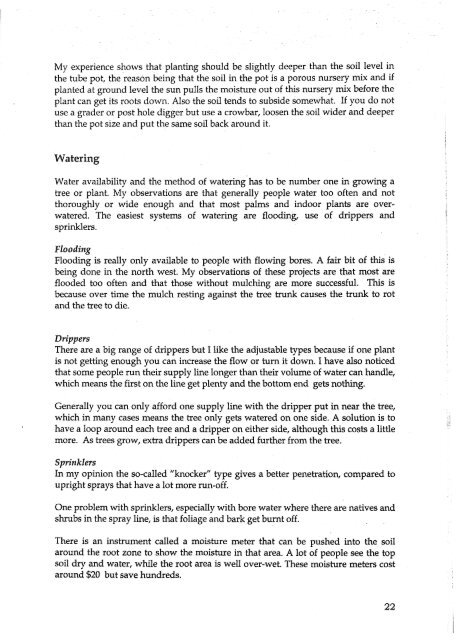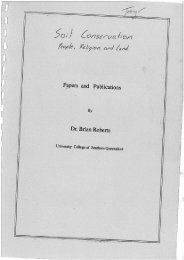western-queensland-gardening-guide.pdf - South West NRM
western-queensland-gardening-guide.pdf - South West NRM
western-queensland-gardening-guide.pdf - South West NRM
You also want an ePaper? Increase the reach of your titles
YUMPU automatically turns print PDFs into web optimized ePapers that Google loves.
My experience shows that planting should be slightly deeper than the soil level in<br />
the tube pot, the reason being that the soil in the pot is a porous nursery mix and if<br />
planted at ground level the sun pulls the moisture out of this nursery mix before the<br />
plant can get its roots down. Also the soil tends to subside somewhat. If you do not<br />
use a grader or post hole digger but use a crowbar, loosen the soil wider and deeper<br />
than the pot size and put the same soil back around it.<br />
Watering<br />
Water availability and the method of wateringShas to be number one in growing a<br />
tree or plant. My observations are that generally people water too often and not<br />
thoroughly or wide enough and that most palms and indoor plants are overwatered.<br />
The easiest systems of watering are flooding, use of drippers and<br />
sprinklers.<br />
Flooding<br />
Flooding is really only available to people with flowing bores. A fair bit of this is<br />
being done in the north west. My observations of these projects are that most are<br />
flooded too often and that those without mulching are more successful. This is<br />
because over time the mulch resting against the tree trunk causes the trunk to rot<br />
and the tree to die.<br />
Drippers<br />
There are a big range of drippers but I like the adjustable types because if one plant<br />
is not getting enough you can increase the flow or turn it down. I have also noticed<br />
that some people run their supply line longer than their volume of water can handle,<br />
which means the first on the line get plenty and the bottom end gets nothing.<br />
I<br />
Generally you can only afford one supply line with the dripper put in near the tree,<br />
which in many cases means the tree only gets watered on one side. A solution is to<br />
have a loop around each tree and a dripper on either side, although this costs a little<br />
more. As trees grow, extra drippers can be added further from the bee.<br />
Sprinklers<br />
In my opinion the so-called "knocker" type gives a better penetration, compared to<br />
upright sprays that have a lot more run-off.<br />
One problem with sprinklers, especially with bore water where there are natives and<br />
shrubs in the spray line, is that foliage and bark get burnt off.<br />
There is an instrument called a moisture meter that can be pushed into the soil<br />
around the root zone to show the moisture in that area. A lot of people see the top<br />
soil dry and water, while the root area is well over-wet. These moisture meters cost<br />
around $20 but save hundreds.
















